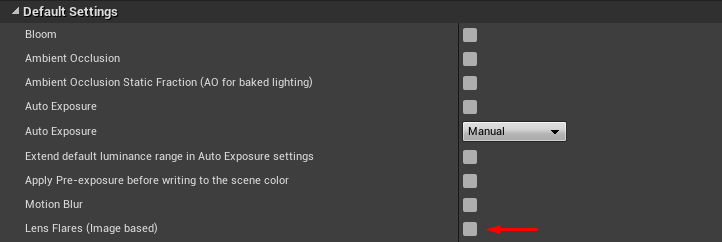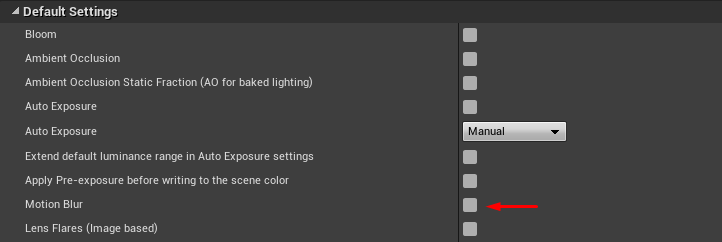Recommended Settings
Note: you are currently viewing documentation for a beta or an older version of Varjo
This page shows the recommended settings for maximizing performance and visual quality for Varjo headsets. Please note that some of the features are not yet supported yet (see notes in the corresponding section).
Refer to the Unreal OpenXR roadmap for an estimated timeline for fixing Instanced Stereo and post-process effects for OpenXR.
INSTANCED STEREO
Instanced Stereo is not supported for Varjo headsets with Unreal Engine 4.27.
Disable instanced stereo rendering in Project Settings > Rendering > VR. Then restart the project.

MOBILE MULTI-VIEW
Mobile Multi-View is not supported for Varjo headsets with Unreal Engine 4.27.
Disable mobile multi-view in Project Settings > Rendering > VR. Then restart the project.

FOVEATED RENDERING
We recommended that you keep foveated rendering enabled when using the Varjo OpenXR plugin. Foveated rendering makes use of the eye tracking functionality in Varjo headsets to improve performance by reducing the image quality in peripheral areas where the user is not looking. Read more about supported dynamic viewport foveated rendering.

HARDWARE OCCLUSION QUERIES
When using Hardware Occlusion Queries the Actor’s visibility is read back one frame later, which can cause them to “pop in” if the camera is moving very fast. This can further cause rendering artefacts with Varjo’s four-viewport setup, especially when using foveated rendering.
We currently recommend to disable hardware occlusion queries. Go to Project Settings > Rendering > Culling and deselect Occlusion Culling.

SMOOTH FRAME RATE
It is generally recommended to disable frame rate smoothing for VR. Go to Edit > Project Settings > Engine > General Settings > Framerate and deselect Smooth Frame Rate.

FORWARD RENDERING AND MSAA
Forward rendering is slightly better visually with roughly the same performance. To use forward rendering, go to Edit > Project Settings… > Rendering and select Forward Renderer:

You can also use MSAA anti-aliasing with Forward Renderer. Go to Edit > Project Settings… > Rendering > Default Settings and select MSAA in the Anti-Aliasing Method:

Performance Tip:
For better performance in some scenes, try disabling Forward Shading and use the Temporal AA anti-aliasing method instead of Forward Shading and MSAA.


SCREEN SPACE REFLECTIONS
Due to the specifics of Unreal Engine and the Bionic Display™ in some Varjo headsets, screen space effects are not working correctly with Varjo headsets. For reflections, use reflection captures instead of screen space reflections.
Screen space reflections can be disabled as seen below. The Screen Space Reflection settings can be found under PostProcessVolume. To disable screen space reflections, select Intensity and set the value to 0.0.

VIGNETTE
Vignette is not supported for Varjo headsets with Unreal Engine 4.27.
Vignette settings can be found from PostProcessVolume Details under Lens > Image Effects. In order to disable Vignette, select Vignette Intensity and set the value to 0.0.

AMBIENT OCCLUSION
Disabling ambient occlusion improves performance and reduces visual quality. Go to Edit -> Project Settings… > Rendering > Default Settings and deselect Ambient Occlusion:

BLOOM
Bloom is not supported for Varjo headsets with Unreal Engine 4.27.
We recommend that you disable the Bloom post-process effect for VR, since it doesn’t perform optimally in VR. Go to Edit > Project Settings… > Rendering > Default Settings and deselect Bloom:

LENS FLARES
Lens flares work well on the screen but feel out of place in VR. We therefore recommended that you disable them. Go to Edit > Project Settings… > Rendering > Default Settings- and deselect Lens Flares (Image based):

EXPOSURE
Due to the specifics of Unreal Engine and the Bionic Display™, auto exposure does not work correctly with Varjo headsets. We recommend using manual and fixed exposure and, for example, disabling the PostProcessVolume camera settings.
To set the manual exposure, deselect Auto Exposure option and set Manual exposure from Edit > Project Settings… > Rendering > Default Settings:

To disable PostProcessVolume, search from World Outliner for your PostProcessVolume (if you have any) and check the settings related to exposure and camera.
In the picture below, we have enabled the Manual metering mode which means that we use only camera settings. The settings are manually tuned to make the VR scene look sharp. As the optimal values depend heavily on the scene, we cannot give specific recommendations for the values and visual tuning is needed.
We recommend that you carefully observe the darkest and most highlighted areas of your scene while trying out the different settings. Note that any lights set in the scene also affect the end result.

MOTION BLUR
In general, motion blur works better on a desktop computer than in VR. We recommend that you disable VR motion blur. Go to Edit > Project Settings… > Rendering > Default Settings and deselect** Motion Blur:

PLANAR REFLECTIONS
Planar reflections are not supported for Varjo headsets with Unreal Engine 4.27.